59 Actionable Ways to Brainstorm Content Marketing Ideas

Do you need help to come up with fresh and engaging content ideas for your marketing campaigns?
Look no further!
I’ve compiled a comprehensive list of 59 actionable ways to brainstorm content marketing ideas to help you stay ahead of the competition and keep your audience engaged.
Learn some of the best ideas for brainstorming content ideas with proven techniques and practical tips you can use immediately. These tools can help you with content marketing ideation, from keyword research to content creation, collaboration, and optimization.
Both pro and beginner marketers can get the inspiration and guidance they need to generate a continuous flow of high-quality content ideas that will resonate with your target audience.
Huge List of Content Brainstorming Techniques
Finding great content ideas can make or break your next piece of content.
But don’t worry. With so many resources available, developing fresh ideas is easier than ever.
1. Use Google Trends To Find Popular Topics
Google Trends is an essential tool for content marketers that provides valuable insights into the latest trends and popular topics in their industry or niche.
Marketers can use Google Trends to identify trending topics, refine their keyword research, discover related topics, and compare search volume over time.
This info can help marketers find timely and valuable content that their audience craves and adjusts their content strategy accordingly.
With Google Trends, content marketers can stay ahead of the curve and increase rankings with not only content for Google’s main search. You can customize content for Google Image, News, Shopping, and even YouTube Search based on what’s growing in popularity!
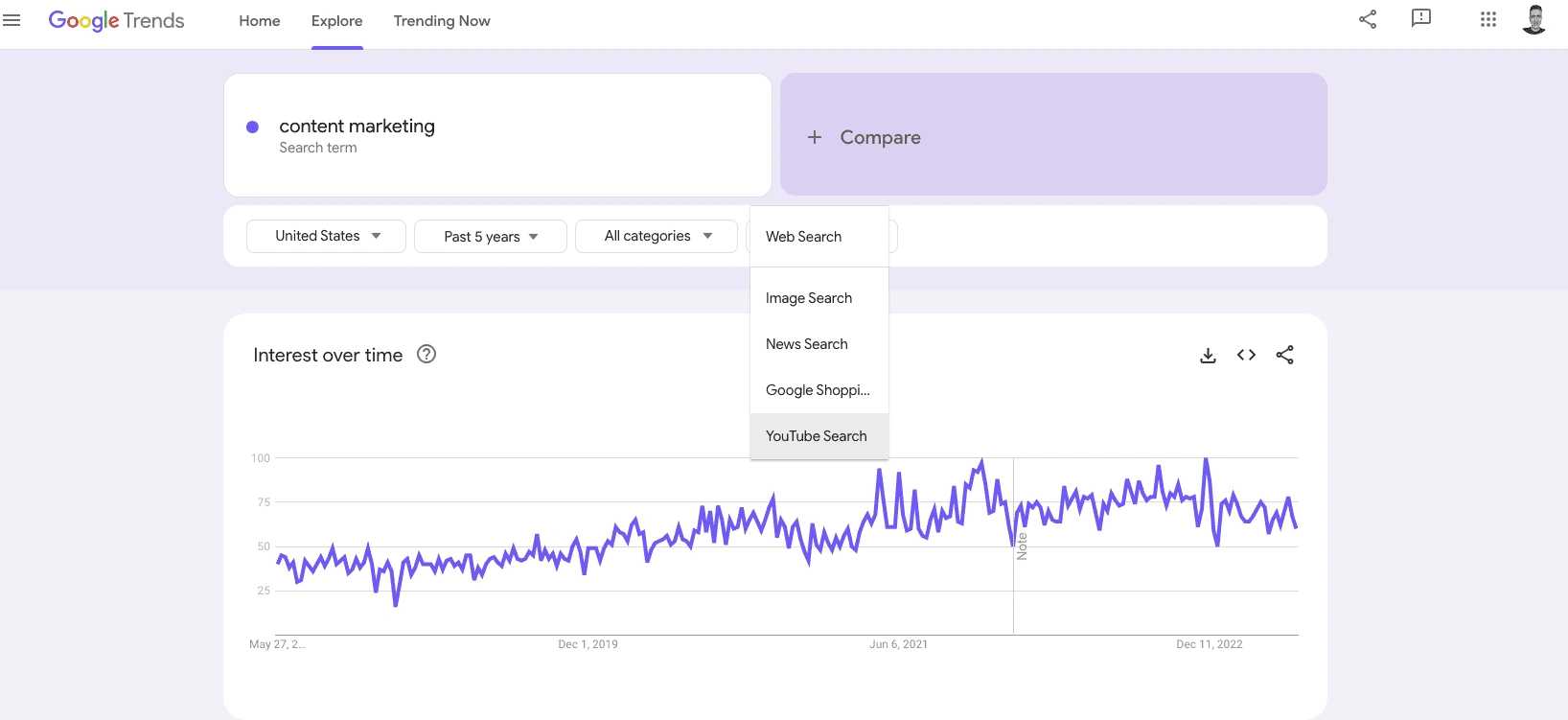
2. Answer the Public
Answer The Public is a content marketing tool that offers several ways to brainstorm topics.
One of its features is generating a list of questions people ask about a particular topic. This helps content creators address the specific questions and concerns of their audience.
The tool provides a list of related topics and queries, which can expand content ideas beyond the initial topic. Not only that, but provides a list of related keywords and phrases, refining keyword research and finding variations of popular keywords.
Answer The Public also visually represents the topic and associated ideas, helping identify patterns or themes for a cohesive content strategy.
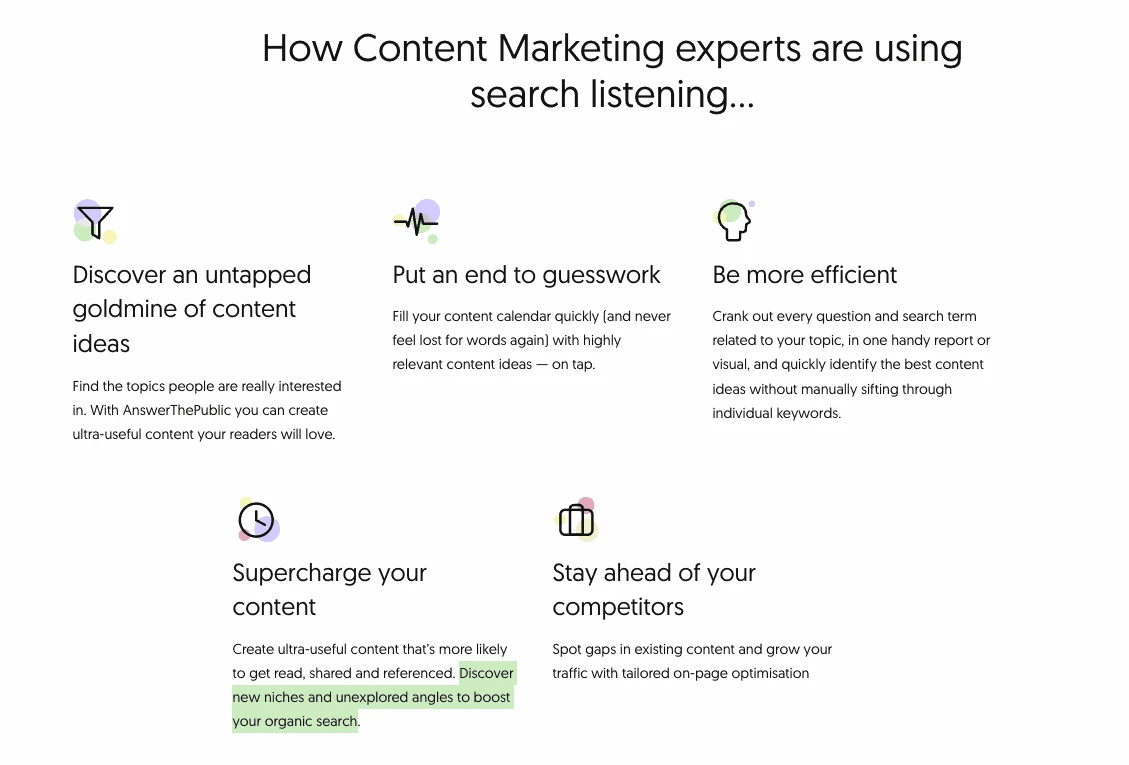
3. Google Autocomplete is…
Google Autocomplete is a valuable tool for content marketers looking to generate new ideas and refine their keyword research.
Google Autocomplete can help you come up with ideas for content by suggesting popular search queries related to your topic. It can also identify common questions and find long-tail keywords that are more specific and relevant to your audience.
Based on the data, you can create content that answers specific questions and ranks higher in search results for more specific queries.
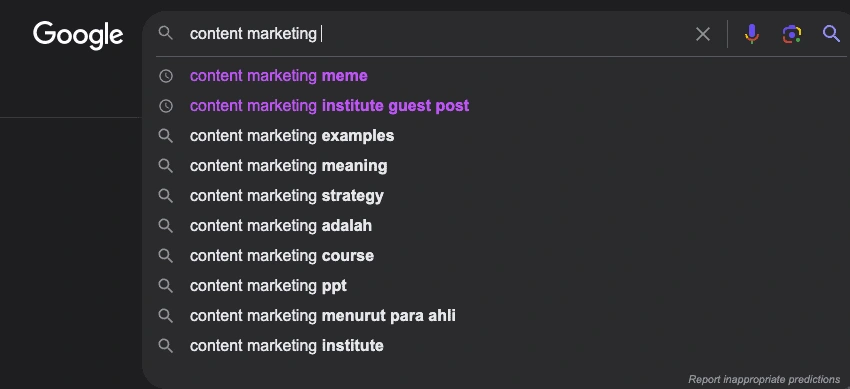
4. Quora search
Quora is excellent for content marketers looking to generate ideas and engage with their target audience.
Discover common questions and concerns within your industry and trending topics that are gaining popularity.
Use the discussions and answers on Quora to inspire your content, whether blog posts, videos, or social media updates.
By providing valuable answers to your audience’s questions, you can build relationships and establish yourself as an expert in your field.
Quora offers industry experts and influencers insights, inspiring your content marketing strategy even more.
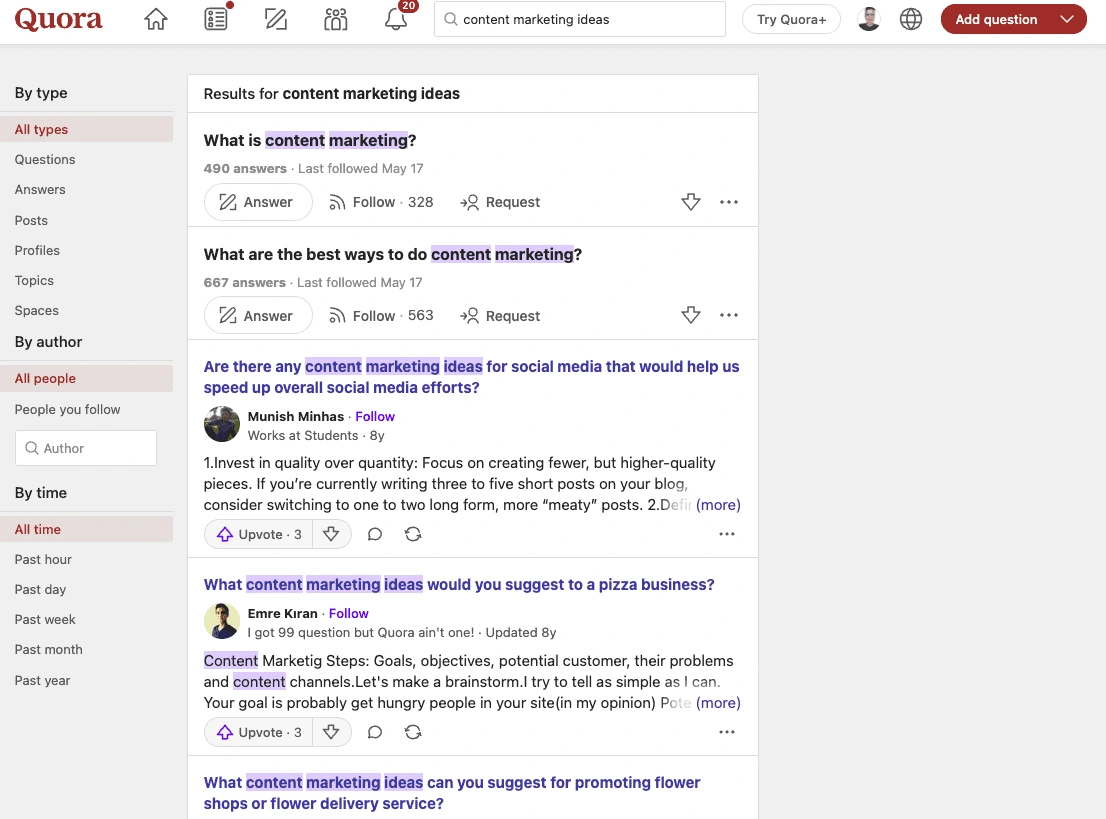
5. Industry forums
By joining forums relevant to your industry or niche, you can tap into the collective knowledge of your peers and find out what topics are currently hot.
You can ask questions, participate in discussions, and understand what topics resonate with your target audience.
Industry forums can also help you identify your audience’s pain points or common questions.
By understanding their challenges, you can create content that addresses their needs and provides valuable solutions.
6. Reddit Search
Reddit is a social news aggregation and discussion platform that can be a fantastic resource for brainstorming content marketing topics.
When you search for subreddits related to your industry or niche, you can discover what people are talking about, their questions, and what content is currently popular.
You can also use Reddit to gather feedback on your existing content and to identify gaps in your content strategy that you can fill with new content ideas.
Reddit’s voting system lets you see the most popular content and which topics generate the most engagement. By staying active on relevant subreddits, you can build relationships with your target audience and create content tailored to their interests and needs.
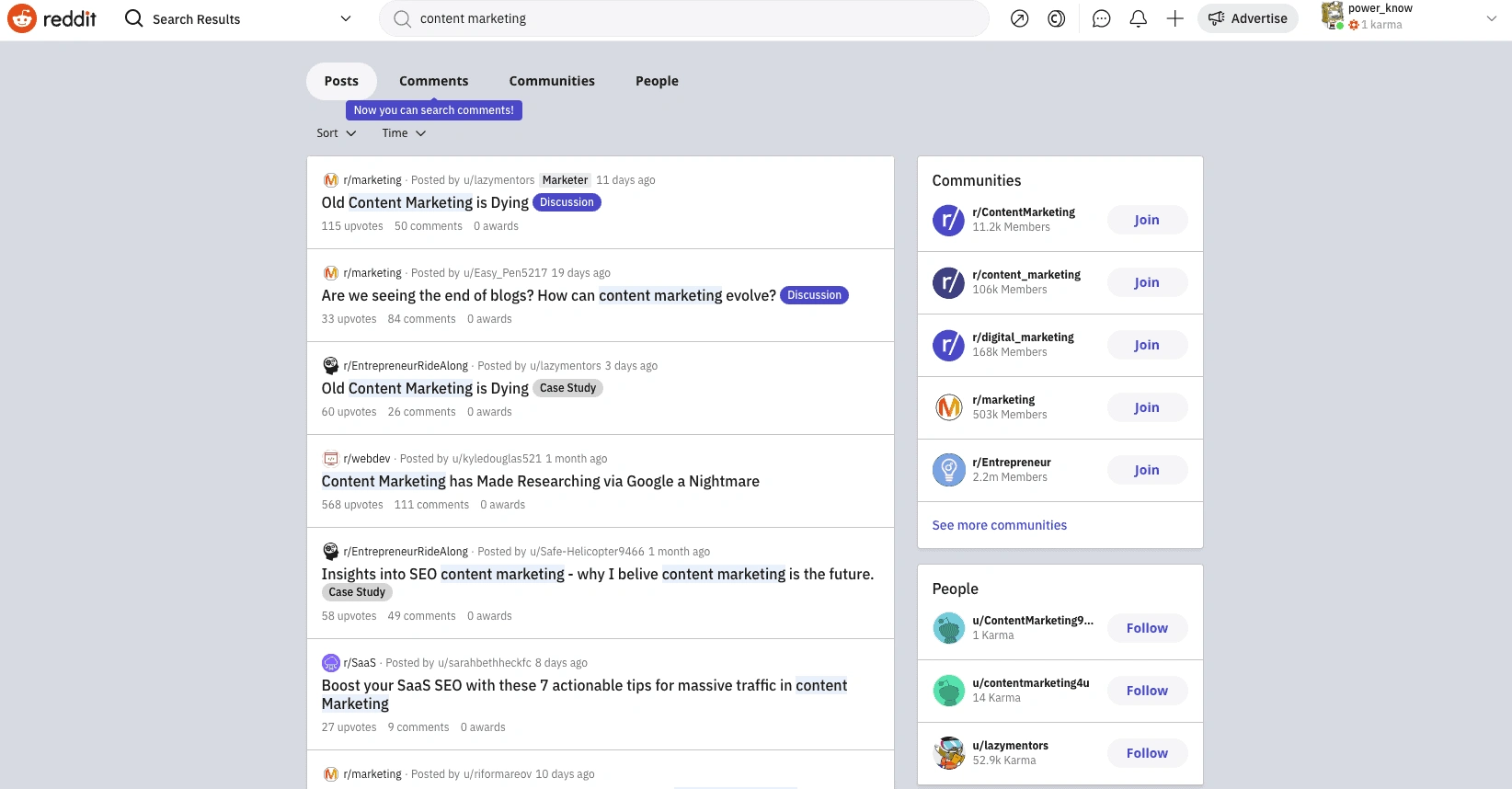
7. Facebook Groups
Join Facebook groups related to your industry or niche and observe what questions people are asking, what topics they are discussing, and what content they share.
Take note of common themes and pain points, and use them to generate ideas for your own content.
You can also participate in group discussions to gain insights and build relationships with potential customers or clients.
Follow the group’s rules and guidelines, and avoid spamming your content.
8. Use Trending Twitter #Hashtags
Twitter hashtags are a way for users to categorize their tweets and make them more easily discoverable by others.
Searching for popular hashtags related to your industry or niche allows you to see what topics people are currently talking about and what kind of content is being shared.
This can give you valuable insights into your target audience’s interest and what type of content will perform well.
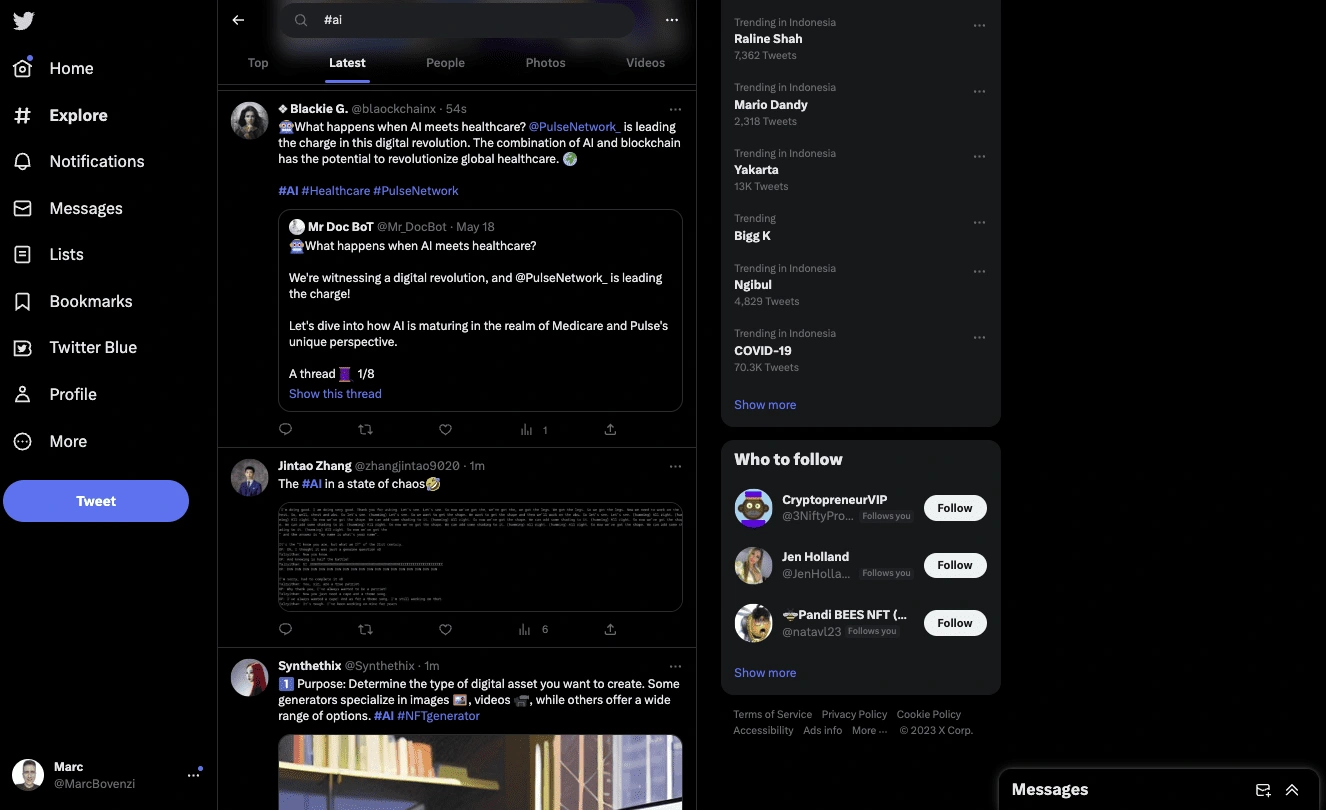
9. LinkedIn Groups
LinkedIn Groups can help you with content marketing topics by connecting you with industry professionals and potential customers with similar interests.
Becoming a group member lets you participate in discussions, identify pain points, and gain insights into your audience’s latest trends and challenges in your niche.
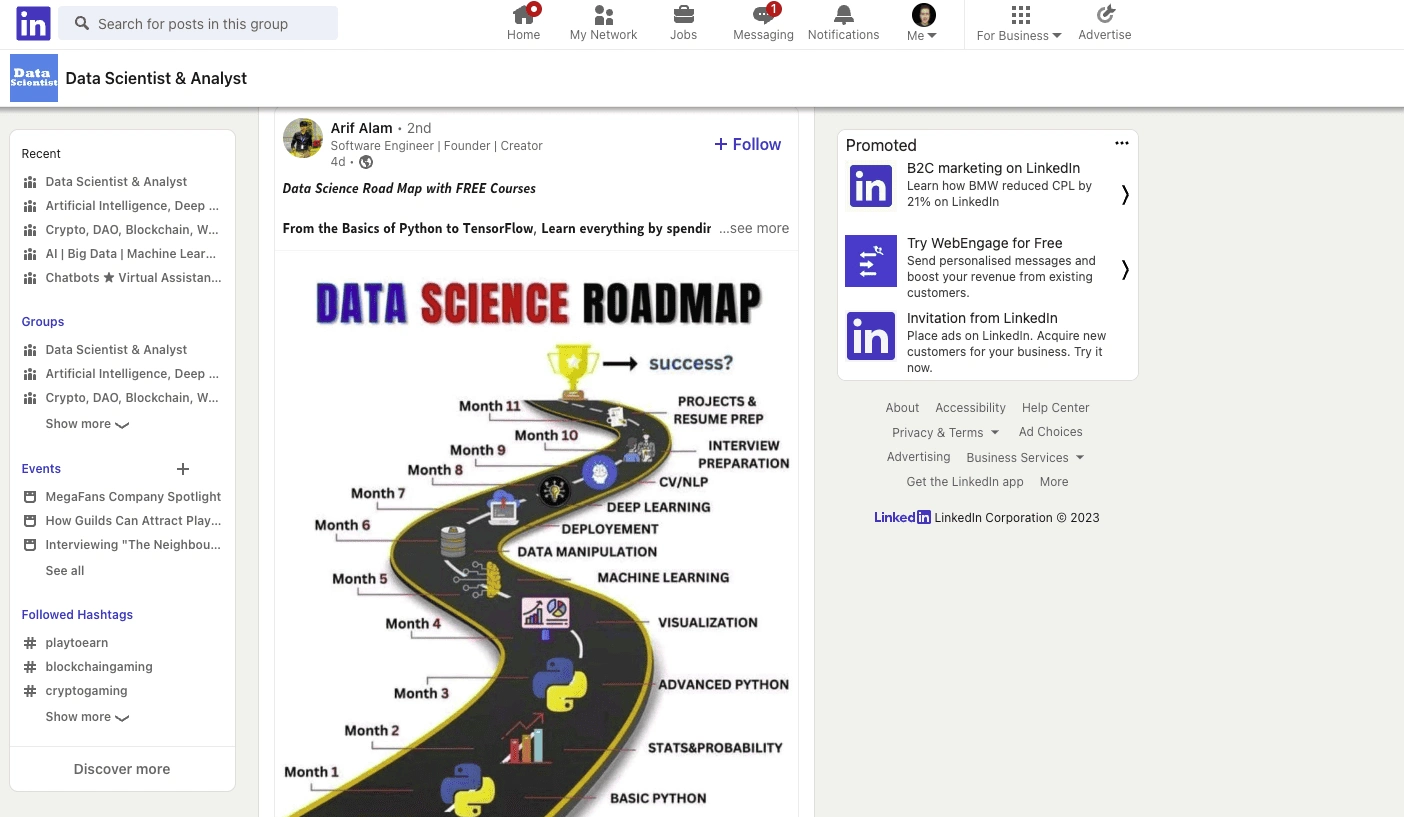
10. Pinterest search + autocomplete
On Pinterest, it’s possible to browse popular pins, boards, and categories in your industry or niche to see what interests people.
Pinterest’s search bar makes finding keywords and phrases related to your topic easy. Just like other search engines, you can also use autocomplete to highlight commonly related searches.
You can even see what content your competitors share and use that as inspiration for your content!
11. Instagram hashtags and stories
On Instagram, you can explore popular hashtags, check out your competitors’ posts, and see your audience’s engagement.
Not only that, Instagram Stories is a way to ask your followers for content ideas or conduct polls to gauge their interests.
*Note that when you search for interior design without hashtags, it will give you different results.
Review all the related post’s hashtags that the person or brand account added because they’re most likely important concepts that you can cover.
12. YouTube comments
Reading YouTube comments can give you a fresh perspective on what your target audience is interested in.
You can gain insights into their pain points, preferences, and questions by reading through comments.
This can help you create content that resonates with them and builds trust. Plus, you can engage with commenters to create a sense of community
As you can read in the comments, people are looking for:
Practical steps to open the space and make it inviting
Specific measurement tips for artwork, curtains, etc.
Buying furniture made of solid wood, metal, or glass
Furniture and decoration placement guidelines
Personalizing artwork
Choosing the right size decorations

13. Customer feedback
Using customer feedback to come up with creative ideas for your website, blog, or social media content is a smart move.
Their opinions can give you insights into what they want to see more of, what topics they find interesting, and even what kind of content they prefer.
So, take a look at your reviews, comments, and surveys, and let your customers guide your content strategy.
14. Internal data is an introvert
Take a look at customer feedback, sales trends, or even internal surveys to identify topics that your audience is interested in.
15. Industry news sources
Industry news sources provide valuable insights into your industry’s latest happenings, trends, and challenges.
By staying updated with industry news, you can identify emerging topics, industry shifts, and new developments that can inspire you to create engaging and relevant content for your target audience.
16. Podcasts
Podcasts are a goldmine for content ideas!
Tune in to industry podcasts to tap into hot topics, get expert insights, and discover what your audience is buzzing about.
From thought-provoking discussions to real-life experiences, podcasts offer a treasure trove of inspiration.
So grab your headphones, dive into podcasts, and let the ideas flow for your next killer content piece!
17. eBooks
You can read in-depth about the latest trending topics, emerging challenges, and innovative solutions by reading ebooks related to your industry or niche.
Ebooks often offer in-depth knowledge and different perspectives, inspiring you to explore new angles for your content.
Also, they provide a wealth of information to spark your creativity when creating engaging content.
A pro tip is to use the search feature to jump straight to the overall topic you’d like to write about in the ebook instead of reading the whole thing.
18. White papers
White papers usually have well-researched findings and expert perspectives on specific topics.
By studying white papers related to your industry, you can gain a deeper understanding of emerging trends and issues.
This knowledge can inspire you to create informative, engaging content that positions your brand as a thought leader.
19. Case studies
By examining real-life examples of how a product or service has benefited customers, you can uncover unique angles to explore in your content.
Case studies provide insights into specific challenges faced by customers and the solutions that worked for them.
Use them to inspire and inform your own content, providing practical and relatable examples for your audience.
20. Webinars
Stay up-to-date with the latest trends and insights by attending webinars in your industry. Experts share their knowledge and discuss emerging topics, providing you with fresh perspectives.
Engaging in live Q&A sessions during webinars can also spark new ideas as you learn from others’ questions and discussions. So stay curious and leverage webinars for content inspiration!
21. Conferences
Conferences bring industry experts and professionals together to learn about the latest trends and how to overcome challenges in your field.
When you attend these types of events, be sure to take notes and engage in discussions because it can help you brainstorm ideas about content topics you might not have considered before.
And don’t forget to network! Sometimes though, the more personal conversations while you’re roaming around the event can lead to much bigger things like content collaborations and guest posting opportunities.
22. SlideShare
SlideShare provides access to a ton of presentations, infographics, and slideshows created by professionals in various fields.
By exploring SlideShare, you can discover unique visuals, insights, and industry-specific knowledge that can inspire you to create fresh content for your target audience.
23. Infographics
Infographics visually present complex information clearly and in a more bite-sized way.
With infographics related to your industry or niche, you can gain inspiration for new topics, unique angles, and data-driven insights.
They can also help identify gaps in existing content and provide a visual framework for structuring your content pieces to be more compelling.
Infographics are also an extremely sharable way to get links back to your site when they post your infographic on their site.
24. Memes
Memes are full of cultural references and the latest gossip.
Not only can you use memes to make your content more fun, but you can also vibe off of the visual style and themes to grab more attention.
It’s possible to create an entire post or article from one meme in a laughable and relatable way.
25. User-generated content
Dive into customer reviews, comments, and social media posts to uncover your audience’s questions, challenges, and experiences. Use their real-life stories, feedback, and perspectives to inspire your next captivating piece.
Let your customers be the driving force behind your content, ensuring its authenticity and relevance to their needs.
26. Google Analytics
Google Analytics reveals popular search queries, top-performing pages, and audience demographics.
Analyzing these data points helps uncover relevant topics, understand what resonates with your audience, and optimize content strategy based on that.
Identify trends, find audience preferences, and produce content that drives engagement and meets your content marketing goals.
27. YouTube search
YouTube is the 2nd largest search engine.
When searching on YouTube, you can see what videos are popular and the topics people like to watch. Keep an eye on the video titles, view counts, and comments so that you can figure out how you can make your content more helpful.
People who go on YouTube usually are there to be entertained or to learn how to do something new.
Using YouTube research isn’t just for YouTubers, and this data can be helpful when creating written and audio content too.
Keep in mind that not all topics on YouTube won’t perform as well in search engines for written content e.g. “How to be a vlogger”.
Another way to use YouTube search to find the content you want to create is to consider the topic suggestions as you type in the search bar. That’s because it’s what other people are searching for.
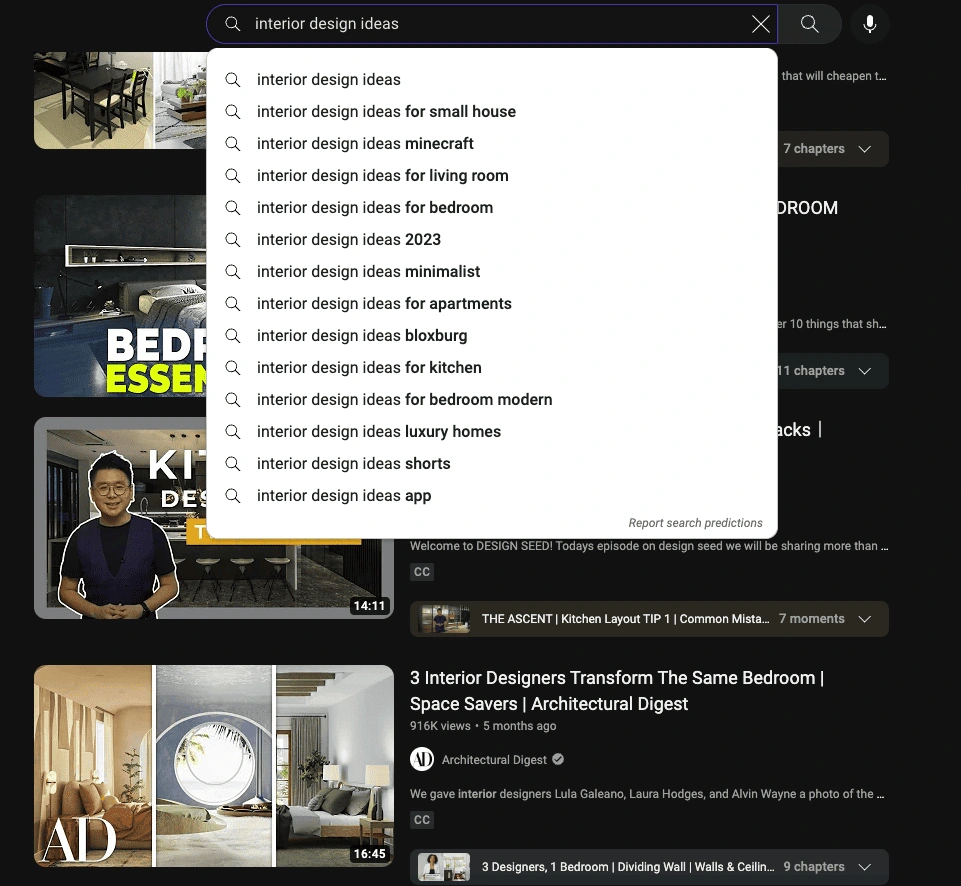
28. BuzzSumo
BuzzSumo has a tool that helps you find popular content related to any topic. It shows you the most shared content on social media platforms, allowing you to see what’s trending and what resonates with your audience.
29. Industry reports
Analyzing industry reports can identify what’s top of mind and what opportunities and challenges that lay ahead.
Leveraging the data, statistics, and expert opinions are awesome for 4 reasons:
Create timely content
Use stats to support your perspective
Reporters love stat and data-rich articles, so you might get mentioned and earn a backlink.
Better chance of getting shared
30. Industry keywords and hashtags on LinkedIn
If you’re a B2B marketer, don’t sleep on LinkedIn.
That’s because it’s more than a prospecting and networking site. It’s chock-full of the latest content ideas.
Search by #hashtags or keywords in the main search bar to find what the latest buzz is in your industry and then capitalize on it.
For a more ninja way, join a group related to the topic you’re writing about. Then search for your desired #hashtag or keyword.
31. Industry meetups
Mingling with other like-minded professionals in your field will help you look at things from a new perspective you may not have considered otherwise. But you don’t just have to attend, say, a marketing meetup if you’re a marketing professional.
Attend industry meetups where your customers will be too. This is much better for creating content angles that speak to your audience’s pain points.
32. Customer service feedback
Creating content such as help articles, FAQs, and blogs that solve your customer’s questions and concerns is pivotal to preventing negative feedback about your brand. Not only that, it shows prospective customers that you care and there is always help right around the virtual corner.
33. Online survey tools
Using online survey tools to gather data on your audience can expose their pain points and reveal their interests, thoughts, and preferences.
It’s important to use open-ended questions, not just yes or no answers, because the more details they provide, the more specific you can make your content to cover their needs.
A tactical way to get people to participate is by using a tool like MixMax to embed the short survey within the email. This way, they can answer without leaving their inbox!
There are always social media polls, but they lack strong statistical and data collection capabilities to generate content ideas.
34. Trending topics on Reddit
Reddit is full of very knowledgeable and opinionated people that join in on the latest conversations and threads. It’s great for seeing both sides of the story to pump your content with the pulse of the online community.
35. Topic clusters
Creating a web of related content on your site is critical for building topical authority.
Topic clusters can be established by making a pillar page first that covers the main topic with several subtopics (like this article you’re reading).
List-based content works well for this.
Then build content that expands on each subtopic and link it back to the main pillar page.
Using topic clusters, especially when you’re site is newer, will signal to Google what your site content is all about.
36. Content gap analysis
Content gap analysis tools reveal what content is missing that your competitors have published, but you haven’t yet.
Most SEO tools have content gap analysis already as one of their features, such as:
SEMrush
Ahrefs
Moz
BuzzSumo
SimilarWeb
SpyFu
Google Search Console
Google Keyword Planner
Screaming Frog
SERPstat
37. Data-driven insights
Content ideas based on one point of data are usually not enough to make a smart content plan.
Using website analytics, social media metrics, and customer behavior together will help you understand what topics resonate with your audience as a whole.
38. Surveys or polls on social media
Connect and directly engage with your audience since you’re most likely creating content.
39. Collaborate with others
Having a group brainstorming session via a discussion, interview, or guest contribution adds more diverse knowledge and perspectives.
An extremely effective way to create content with actionable ideas is to organize an “expert roundup post” about a common problem people face and how others solve it.
40. SEO plugin tools
SEO plugin tools for your internet browser can be valuable for generating content ideas.
Gain insights into popular search terms, keyword variations, and related topics that uncover what people are actually searching for.
By analyzing search data and trends, you can discover relevant topics with a higher potential for visibility and engagement, improving your content strategy and attracting more organic traffic.
41. Slack, LinkedIn, and Discord Communities
Being a part of an industry-specific community is like networking and support on steroids!
Groups for SEO professionals and content marketers are extremely active in sharing their ideas.
Some of the free and paid groups include:
42. Content scoring
Predict and evaluate the success of content ideas by assigning scores.
Criteria may include relevance, uniqueness, and audience appeal.
Using content scoring allows you to focus on only writing high-quality content that stands out from the crowd.
Low-quality content ideas? Ain’t nobody got time for that!
43. Keyword search modifiers
By adding depth and specificity, keyword search modifiers can enhance your content marketing topics.
By incorporating modifiers like “best,” “top,” or “guide,” you can target specific audience needs. For example, “best social media strategies” or “Guide to SEO Optimization.”
These modifiers help you generate ideas that cater to your audience’s preferences and provide the valuable, focused content they seek.
44. Email marketing from industry and competitors
Analyzing your competitors’ email campaigns can provide valuable insights into the types of content that resonate with their audience.
That’s why it’s a good idea to pay attention to their subject lines, email structure, and content topics.
Don’t forget to swipe some ideas from other industry emails that are full of potential content ideas.
45. Content calendars
Content calendars help in planning and organizing your content strategy.
You can ensure a consistent flow of engaging content by mapping out topics, themes, and publishing dates in advance.
Content calendars allow you to see the big picture, identify gaps, and generate ideas for future content.
They provide a visual roadmap, helping you stay organized and focused on delivering valuable content to your audience.
46. Google Images
By searching for relevant visuals related to your niche or industry, you can gain inspiration for new topics and angles to explore.
Visual content can spark creativity and help you think outside the box.
Not only that, but you can read the article titles and see what topic is ranking #1 in the image results.
Discovering unique images can lead to writing the next 1,000 words that set your brand apart.
A picture is still worth a thousand words, right?
47. Customer personas
Personas provide insights into topics, formats, and messaging that will connect with our audience on a deeper level.
Before coming up with content ideas – this should be your top priority.
48. Influencer marketing
An influencer’s unique perspective can provide endless content inspiration because they’re usually involved with what’s popular now.
Influencers are paid to sponsor brands and individual products.
So, find influencers in a similar industry and listen to what and how their audience is interacting with them to find as many ideas as possible.
49. Content analysis frameworks
Analyzing existing content, identifying patterns, and evaluating performance, can uncover topics, angles, and formats that resonate with your audience.
These frameworks help guide your content strategy, ensuring your future content is engaging and impactful.
50. Content Curation tools
Content curation tools help discover new ideas by aggregating and organizing relevant content from various sources.
They provide a convenient way to explore trending topics, industry news, and popular articles, allowing you to stay informed and find inspiration for your content.
51. Google or Bing “People Always Ask”
In the search results, Google and Bing’s “People Also Ask” feature shows popular questions related to your topic that people want to know about.
Use it to create relevant, engaging content that solves their questions in detail with real examples to show off your expertise.
52. Google Alerts
Google Alerts keeps you updated on topics of interest by sending notifications directly to your inbox.
Stay in the loop with industry trends, news, and conversations, helping you generate a number of ideas.
Set up Google alerts for specific keywords or phrases relevant to your niche and receive inspiration straight to your email.
53. Mind Mapping
Mind mapping is similar to the skill of creating article outlines.
Start with the main focus topic and branch out with related subtopics.
It encourages free-flowing thinking and helps visualize connections between ideas.
Plus, it’s a creative way to explore different angles and expand your content possibilities.
54. Word Association
Word association is a fun and creative technique to get content ideas.
Start with a topic and quickly jot down related words that come to mind.
Explore each word and see how they can inspire unique content angles or themes.
Then, go with your creative flow!
55. Free-writing
For 10 minutes, write anything that comes to mind on a notepad.
Don’t worry about grammar or structure.
Use your instinct and let your thoughts come to you with this brainstorming exercise.
56. Site search data
If your site has a search bar, you’ll be able to check your analytics to see what people are curious about.
Figure out which topics should be made priority ideas for your content.
57. Open AI / Chat GPT
Using AI like Chat GPT is one of the best tools to explore niche angles and suggest unique approaches for your topics.
Once you narrow down what you’d like to talk about.
Ask Chat GPT to make an original article outline or audio/video script for you based on the specific topics you chose.
You can even ask it to include specific keywords in the H titles.
58. Microsoft Bing Search Performance
If you’re struggling to come up with better ideas for your content, try Microsoft Bing Search Performance.
This tool offers data on trending topics and popular search queries, which could help you create more engaging content that resonates with your target audience.
You can fine-tune your content by analyzing search volume, click-through rates, and demographic data to make it more relevant and impactful.
It’s definitely worth exploring if you want to step up your content game.
59. Microsoft Bing You “Autocomplete” Me
Bing’s autocomplete feature is similar to Google’s autocomplete.
The reason you should be using Bing is that people search differently from other search engines.
Especially now that Bing has integrated AI into their search engine!
Learn about the burning questions people have based on what people are typing to come up with a list of popular searches.
So there you have it! Finding content marketing ideas can be easy.
With so many resources available, you simply have to get creative and keep trying until you hit that perfect idea.
Remember to keep track of what’s working so your marketing team can adjust your approach as needed.
By keeping up with trends and being persistent, you’ll continue to create content your audience will love.
So go ahead and do a brainstorming session – your next great idea could be just around the corner!
FAQ
How do you brainstorm for content marketing?
To brainstorm for content marketing, remember to be open-minded, take risks, and enjoy the process! Follow these basic steps:
Set clear goals for what you want to achieve with your content.
Understand your audience’s needs and preferences, and stay updated on industry trends.
Use different brainstorming techniques like mind mapping or free-writing to generate ideas.
Get inspiration from various sources like blogs, social media, and conversations.
Evaluate and prioritize your ideas based on relevance and feasibility.
Refine and develop your chosen ideas into compelling content pieces.
Like this project
Posted Jul 1, 2023
Do you need help to come up with fresh and engaging content ideas for your marketing campaigns?
Likes
0
Views
18






